Furniture isn’t just another e-commerce category—it’s one of the most consistent and profitable niches in the US online market. Unlike impulse buys or seasonal goods, furniture is a long-term purchase. When a customer invests in a new sofa, desk, or dining set, they’re willing to spend more, and that creates larger margins for sellers.
The numbers back this up. In 2024, the US online furniture and home furnishings market generated over $78 billion in sales, and growth is expected to continue in 2025 as more Americans turn to online platforms for home upgrades. Social media and design trends also play a big role, with Pinterest, Instagram, and TikTok inspiring everything from minimalist shelving to multifunctional home office setups.
For dropshippers, the appeal is clear: furniture combines steady demand, high average order values, and endless variety. But success in this space depends heavily on choosing the right partners. Reliable wholesale dropship suppliers in the US can provide not only quality products but also faster shipping and better after-sales support—two things that are essential for keeping customers happy.
In this guide, we’ll highlight the 10 best furniture wholesale dropship suppliers for the US market in 2025, along with practical tips to help you build a profitable and sustainable business in this growing niche.
The Growth of the US Online Furniture Market
The US furniture industry has been undergoing a steady transformation, with more consumers choosing to shop online instead of visiting traditional showrooms. By 2024, digital sales will already represent a significant share of the overall furniture market, and analysts expect this upward trend to continue well into 2025.
Several factors are driving this expansion:
-
Changing Consumer Behavior: Surveys show that nearly 35% of US shoppers now prefer to buy furniture online, compared to less than 20% a decade ago. Convenience, wider selection, and the ability to compare prices instantly are major draws.
-
Social Media Influence: Platforms like Pinterest, TikTok, and Instagram are shaping furniture trends more than ever. From minimalist office desks to multifunctional shelving, viral content often inspires consumer demand.
-
Remote and Hybrid Work: The shift to remote work has boosted demand for home office furniture, ergonomic chairs, and organizational solutions. As more people redesign their living spaces, functional furniture has become a priority.
-
Affordability and Financing Options: Online platforms frequently offer lower prices than brick-and-mortar stores, as well as installment payment plans. This accessibility is encouraging more middle-income households to shop online.
-
Logistics Improvements: Faster delivery options, warehouse expansion, and white-glove services are making bulky furniture purchases more seamless than ever.
For dropshippers, this growth means the US market is not only large but also ripe for niche targeting. Sellers can tap into categories such as small-space solutions, trendy décor, or affordable office furniture to capture specific customer segments. With the right supplier partnerships, dropshippers can align with these consumer shifts and build sustainable revenue streams in 2025.
Key Qualities of a Reliable Furniture Dropshipping Supplier
Furniture is different from small, everyday e-commerce products. It’s heavier, often more fragile, and buyers expect it to last for years. That means the choice of supplier can make or break your dropshipping business. A reliable US furniture dropshipping supplier should demonstrate the following qualities:
1. US-Based Warehouses
Delivery time is critical. Customers are less willing to wait weeks for a sofa or desk. Suppliers with warehouses in the US (and ideally multiple locations) can cut shipping times to just a few days, which improves customer satisfaction and helps sellers compete with giants like Amazon.
2. Wide and Versatile Product Range
The best suppliers offer a variety of categories—living room, bedroom, dining, outdoor, and office furniture. A broad catalog gives dropshippers flexibility to test different niches, from high-ticket statement pieces to compact storage solutions that are easier to ship.
3. Strong Logistics and Handling
Large furniture requires special handling, and damage during shipping can ruin both profits and reputation. Reliable suppliers have partnerships with trusted carriers, offer freight services, and sometimes even provide white-glove delivery for premium buyers.
4. Quality and Warranty Support
Furniture is a higher-investment purchase, and customers expect durability. Suppliers who provide warranties or guarantee return support increase customer confidence and reduce risk for dropshippers.
5. Dropshipping-Friendly Systems
Good suppliers make life easier for sellers with features like real-time inventory syncing, product data feeds, automated fulfillment, and even branding support. These services reduce manual work and help stores scale smoothly.
6. Competitive Wholesale Pricing
Margins matter more in furniture because of the logistics costs involved. Suppliers who offer competitive wholesale pricing or tiered discounts give dropshippers room to stay profitable even when running ads or covering delivery fees.
In short, the best US furniture dropshipping suppliers combine speed, variety, quality, and dependable systems. Partnering with these suppliers allows sellers to focus on marketing and customer experience instead of worrying about delays, damages, or complicated logistics.
10 Best Furniture Dropshipping Wholesale Suppliers for USA
1. Wayfair Professional
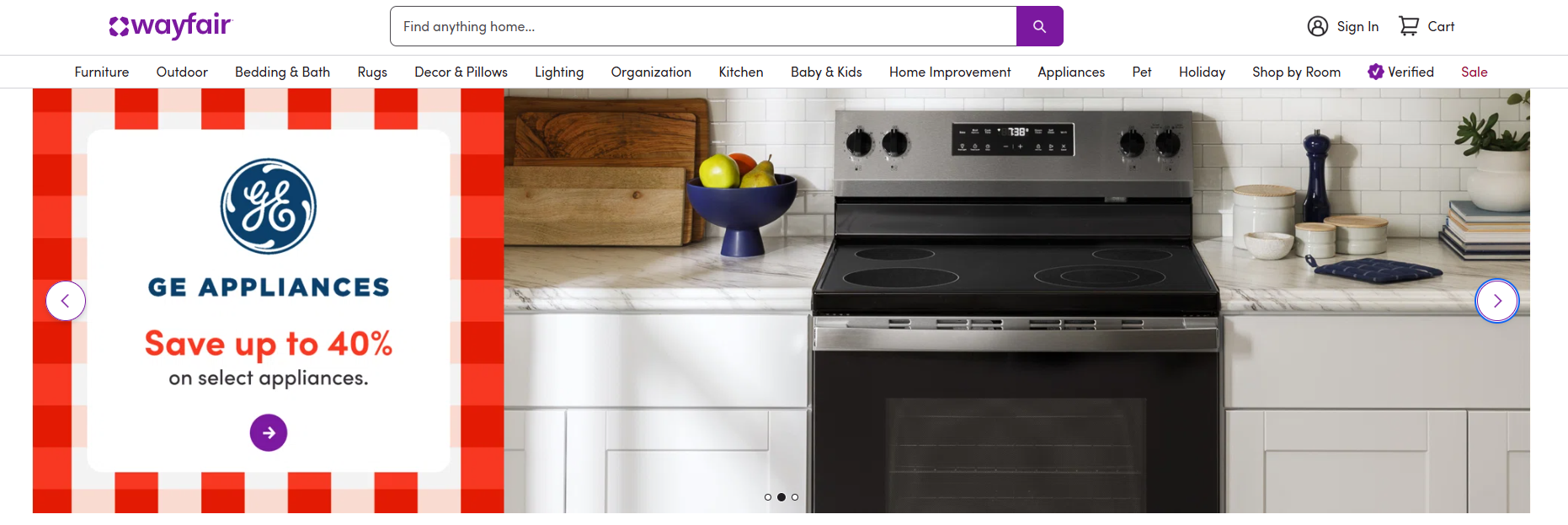
Wayfair is one of the largest online furniture retailers in the US, and its Wayfair Professional program caters directly to business buyers. With millions of SKUs spanning every furniture category—living, dining, office, outdoor—dropshippers gain access to a huge selection that resonates with American households. Their US-based warehouses ensure faster delivery, and their name recognition helps new stores build credibility.
Best for: Sellers who want to offer a wide catalog and tap into mainstream furniture demand.
Watch out for: Competition can be high, so strong branding and unique marketing are needed.
Advantages
-
Strong U.S. logistics, large inventory, and consolidated delivery options.
-
Trade pricing, invoicing, and dedicated pro support.
-
Broad assortment across price tiers and categories.
Disadvantages
-
Not optimized for single-item dropship models or low-volume sellers.
-
Margins can be tighter versus lower-cost suppliers.
-
Marketplace competition and platform fees may apply.
Why choose Wayfair Professional
Ideal for designers or B2B buyers needing dependable U.S. fulfillment, project tools, and trade terms for medium-to-large orders.
2. Ashley Furniture
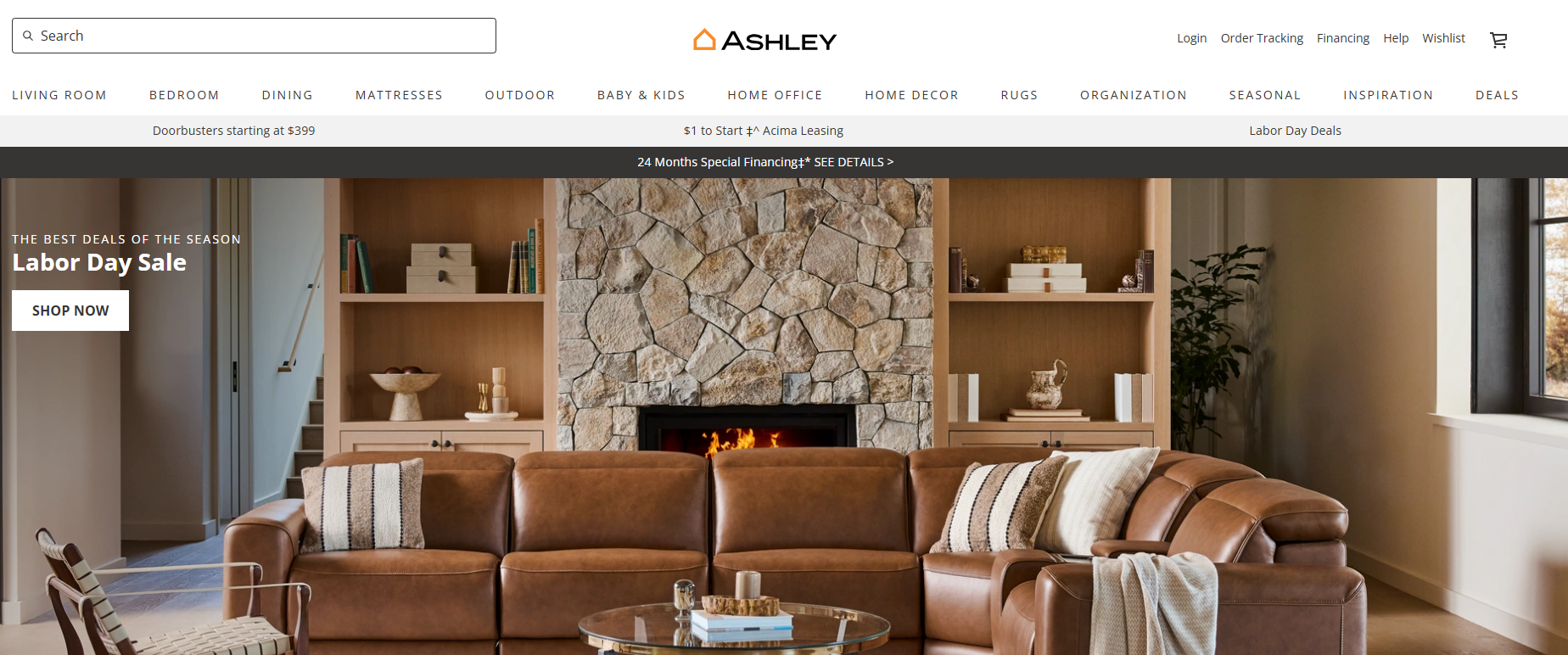
Ashley is one of the most established furniture brands in the US, known for reliable designs and nationwide recognition. Partnering with Ashley gives dropshippers access to trusted product lines that already have strong demand. Their range spans sofas, bedroom sets, and home office furniture, which appeals to mid-range buyers.
Best for: Dropshippers targeting mainstream, family-oriented US households.
Watch out for: Branding is consistent, so margins may be slimmer than with niche suppliers.
Advantages
-
Strong brand recognition, consistent quality, and warranties.
-
Large product range and mature distribution network.
-
Reliable after-sales service and national logistics.
Disadvantages
-
Higher wholesale costs and entry requirements for small sellers.
-
Limited flexibility for private labeling or rapid SKU testing.
-
Not optimized for low-margin, high-test dropshipping playbooks.
Why choose Ashley Furniture
Choose Ashley when brand trust, consistency, and comprehensive after-sales support are key to your retail or project strategy.
3. Wholesale Interiors (Baxton Studio)
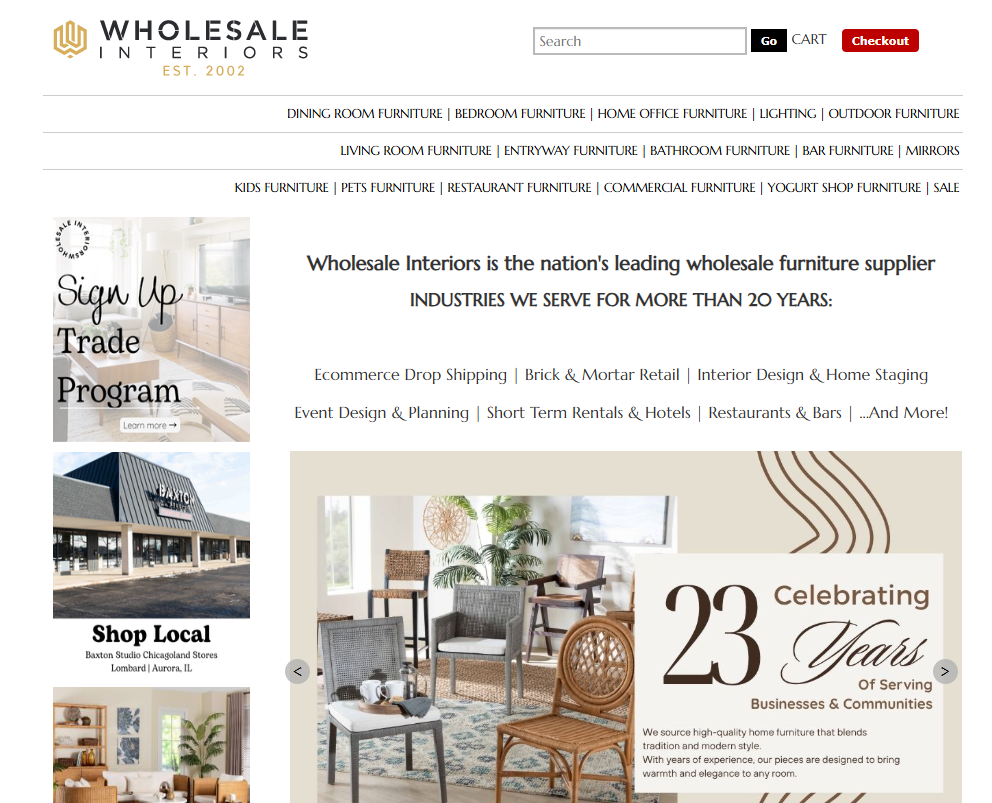
Wholesale Interiors, also known by its Baxton Studio line, specializes in contemporary and modern furniture. Their trendy designs—from minimalist chairs to Scandinavian-style sofas—align with current TikTok and Pinterest aesthetics. With established distribution centers in the US, shipping times are efficient.
Best for: Sellers targeting design-conscious buyers who want affordable style.
Watch out for: Product lines are more trend-driven, so seasonal shifts in demand can occur.
Advantages
-
Curated, retail-ready collections and B2B wholesale support.
-
Designed for reliable U.S. shipping/retail display.
-
Good for repeatable assortments and merchandising.
Disadvantages
-
Wholesale terms or MOQs may limit tiny sellers.
-
International shipping/returns are costly.
-
Slower replenishment versus fast-trend suppliers.
Why choose Wholesale Interiors / Baxton Studio
Pick this when you want cohesive mid-market collections and a stable wholesale relationship for retail or contract sales.
4. Modway
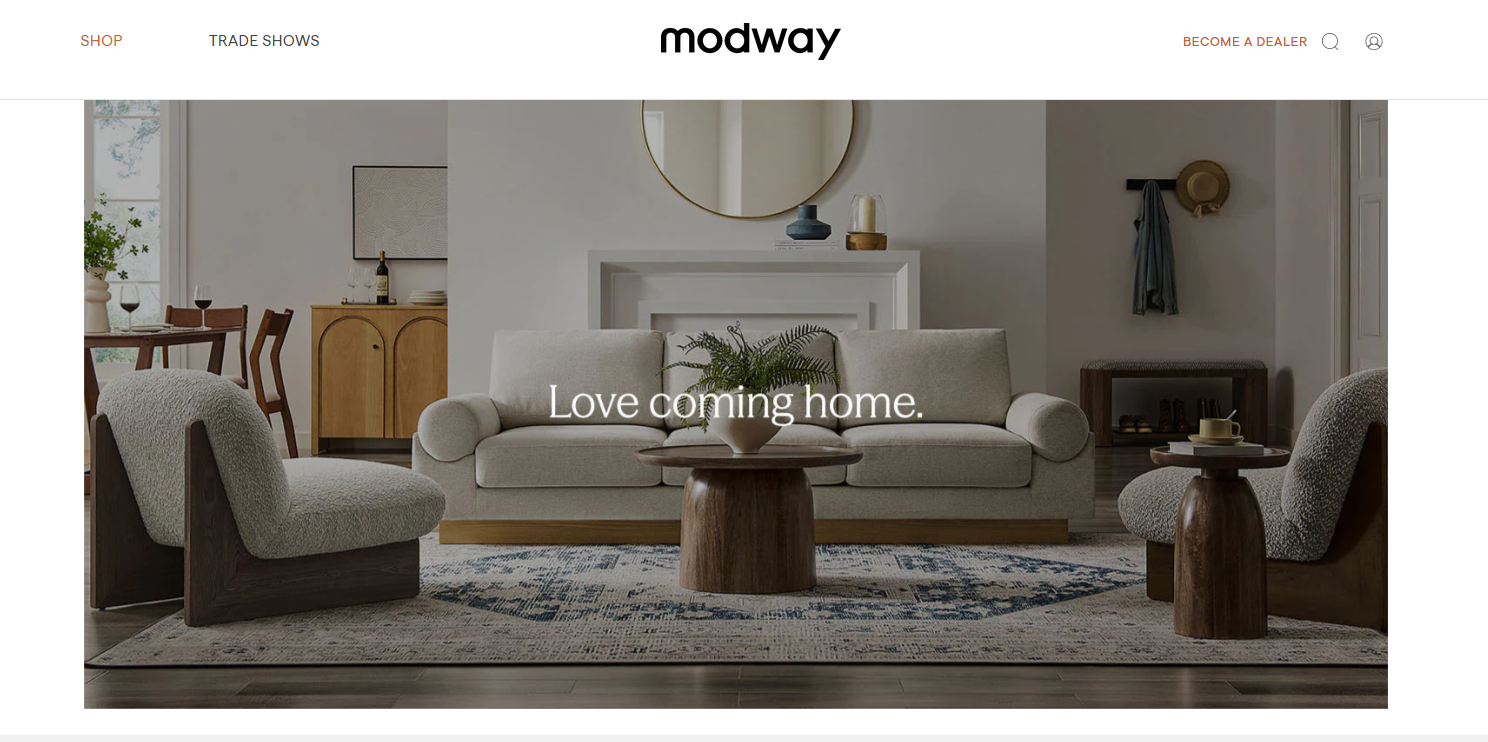
Modway is a favorite among dropshippers for its versatile catalog and competitive price points. From living room and dining furniture to office chairs and outdoor pieces, Modway caters to a broad spectrum of buyers. Their focus on affordability without compromising style makes them especially appealing to younger demographics shopping online.
Best for: Stores aiming to balance affordability and aesthetics.
Watch out for: Large items may involve higher freight costs—clarify shipping policies upfront.
Advantages
-
Strong modern aesthetic and cohesive collections.
-
Competitive price-to-design balance for mainstream shoppers.
-
Widely available through multiple dealers and channels.
Disadvantages
-
Limited high-end customization or private-label options.
-
Some items require complex shipping/assembly.
-
Not oriented toward bespoke or artisan products.
Why choose Modway
Good for stores focused on contemporary design that want predictable turns and consumer appeal at mid-market prices.
5. VidaXL
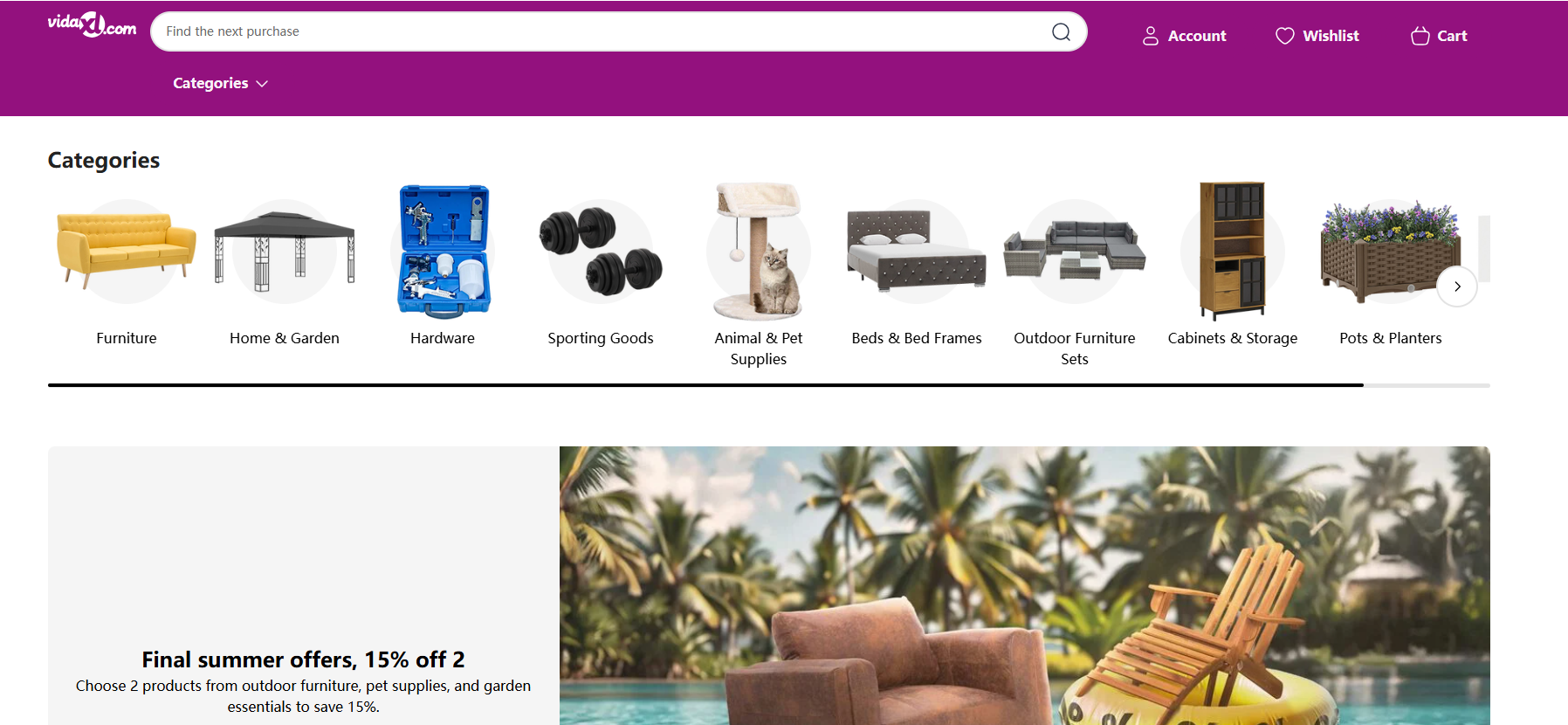
VidaXL is a global furniture supplier with US-based warehouses, making it suitable for dropshippers who want fast fulfillment. Their catalog includes home, garden, and office furniture at accessible price points. VidaXL is especially strong in outdoor and DIY-style furniture, which adds diversity to a product lineup.
Best for: Sellers looking for breadth of categories, including outdoor and lifestyle.
Watch out for: Since they operate globally, catalog overlap with European markets is common.
Advantages
-
Enormous SKU breadth suitable for catalog expansion.
-
Competitive pricing and frequent promotions.
-
Strong European fulfillment footprint.
Disadvantages
-
Product quality and consistency vary across categories.
-
Less fitting for premium branding or curated assortments.
-
US shipping/returns need per-SKU validation.
Why choose vidaXL
Choose vidaXL for breadth-heavy, cost-sensitive strategies or when testing many low-cost SKUs across markets.
6. Costway

Costway is well-known in the American market for affordable home and lifestyle goods, including a wide selection of furniture. Their warehouse network within the US ensures quicker delivery times, and they’re popular for both functional items (like desks and storage) and decorative pieces.
Best for: Beginners who want reliable fulfillment and affordable pricing.
Watch out for: Some designs are mass-market; differentiation will rely on marketing.
Advantages
-
Price-competitive products for value segments.
-
Readily available stock and promotional cadence.
-
Simple, practical assortments that convert on price.
Disadvantages
-
Durability/finish may not match premium expectations.
-
Bulky-item logistics and returns can be costly.
-
Limited differentiation for brand positioning.
Why choose Costway
Best when your customer base prioritizes low price and fast turnover rather than premium quality.
7. Houzz Marketplace
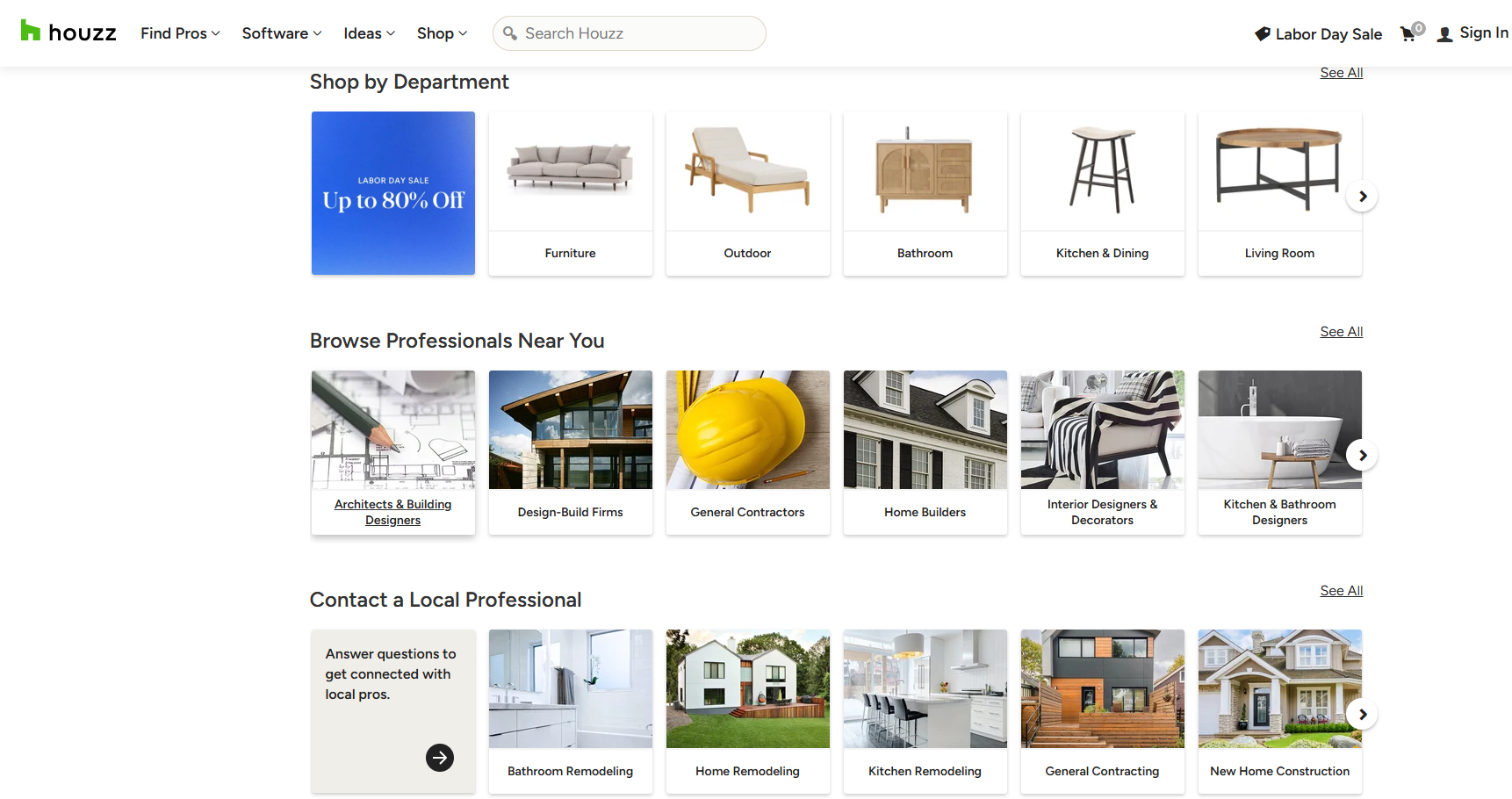
Houzz has become a popular online destination for home improvement and furniture shopping. Their marketplace allows dropshippers to connect with homeowners actively looking for design inspiration. Houzz’s audience is style-focused and often spends more per purchase, making it a good platform for premium or niche furniture.
Best for: Sellers targeting design-savvy buyers willing to pay more for aesthetics.
Watch out for: Marketplace fees and high competition from established sellers.
Advantages
-
High-intent audience and strong project discovery tools.
-
Excellent for designers and pro referrals.
-
Opportunity for long-term, project-based sales.
Disadvantages
-
Higher expectations for presentation, quality, and service.
-
Competitive vendor onboarding and potential fees.
-
Better suited to sellers with strong portfolios.
Why choose Houzz
Ideal for sellers targeting professional referrals and customers actively planning remodels or large purchases.
8. Sagebrook Home
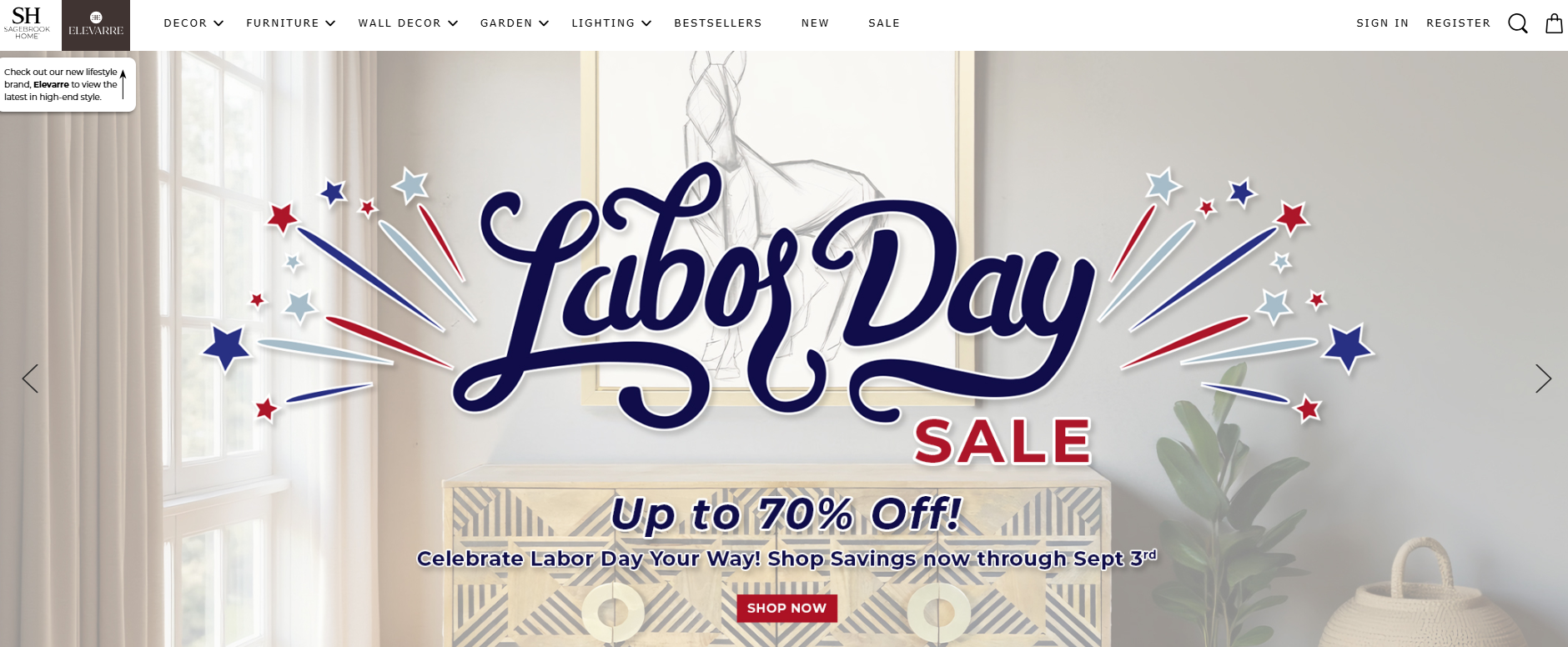
Sagebrook specializes in stylish accent furniture, home décor, and accessories that bring character to interiors. Their catalog appeals to dropshippers aiming at the decorative furniture and lifestyle niche, such as side tables, accent chairs, and decorative shelving. They also update collections regularly to stay aligned with seasonal trends.
Best for: Stores focused on home décor and affordable luxury pieces.
Watch out for: Limited in large statement furniture; better for accent categories.
Advantages
-
Strong accessory assortments for cross-selling.
-
Wholesale-friendly terms for boutique retailers.
-
Fast style turnover for seasonal merchandising.
Disadvantages
-
Low unit value increases relative handling/return costs.
-
Seasonal inventory requires active management.
-
Not a primary source for large furniture items.
Why choose Sagebrook Home
Use Sagebrook to boost AOV and round out furniture assortments with decorative and finishing pieces.
9. Doba

Doba is a dropshipping directory that connects sellers with multiple US-based suppliers, including furniture vendors. Its platform simplifies operations with centralized inventory management, fulfillment automation, and order syncing. Doba’s strength lies in giving sellers one dashboard to test suppliers and manage scale.
Best for: Sellers who want to experiment with multiple suppliers at once.
Watch out for: Platform fees may reduce margins for smaller-scale sellers.
Advantages
-
One portal for many suppliers—fast SKU expansion.
-
Centralized order/inventory automation and platform integrations.
-
Useful analytics and curated product selection tools.
Disadvantages
-
Platform fees and supplier margins can compress retail profit.
-
Variable supplier reliability—requires vetting.
-
Large furniture logistics may need special handling outside standard flows.
Why choose Doba
Best if you want rapid catalog growth and simplified supplier management; verify logistics support for bulky items first.
10. CJdropshipping

CJdropshipping offers flexibility that many furniture dropshippers value. While known for a broad product catalog, they also provide product sourcing on demand, allowing sellers to request specific furniture styles not listed publicly. With US warehouses for faster delivery, automated order fulfillment, and custom packaging options, CJdropshipping helps stores stay competitive in a demanding niche like furniture.
Best for: Sellers who want sourcing flexibility and branding options beyond standard catalogs.
Watch out for: Some large furniture items may involve longer handling times, so choose SKUs strategically.
Advantages
-
No subscription/minimums for core services; low upfront cost.
-
Very large SKU selection and active sourcing team.
-
Multiple global warehouses and integrations for automation.
Disadvantages
-
Product quality varies; sampling and QC are required.
-
Platform complexity — useful features require learning.
-
Cross-border returns and customer experience need active management.
Why choose CJdropshipping
Best for merchants who want to test many SKUs quickly, minimize upfront investment, and scale via automation and flexible warehouse options.
How to Choose a Furniture Dropshipping Supplier (US-focused)
Start with logistics and delivery performance. For US customers, fast and reliable shipping is a competitive advantage. Prioritize suppliers with US-based warehouses or consistent express fulfillment options that can deliver within 3–7 business days nationwide. Ask for average transit times to major regions (West Coast, Midwest, Southeast) and request tracking integration for every order.
Quality control is non-negotiable for furniture. Request product samples before listing — inspect materials, assembly hardware, finish, and packaging. Verify dimensions and load ratings; mismatches are frequent in furniture listings. Look for suppliers offering pre-shipment inspections, CE/UL markings where applicable, and clear warranty policies.
Returns and reverse logistics are often the hidden cost in furniture dropshipping. Prefer suppliers that accept returns to a US warehouse, offer prepaid return labels, or provide clear RMA procedures. Clarify who pays for return shipping and restocking fees, especially for bulky items.
Integration and automation reduce manual errors. Choose suppliers that provide a Shopify (or WooCommerce) app or an API for automated inventory sync, pricing rules, and order fulfillment. Confirm how stockouts are communicated — immediate syncs are essential to avoid canceled orders.
Pricing transparency and margin support matter. Get a full landed cost: product price, packing, dimensional weight shipping, insurance, and any warehouse fees. Use that landed cost to set retail pricing that covers advertising and returns. Beware suppliers with low product prices but high, opaque shipping surcharges.
Customer service responsiveness is a practical KPI. Test response times across time zones (email, live chat, phone). Suppliers that assign dedicated account managers reduce friction during scaling.
Finally, check references and reviews from other US sellers. Ask for performance metrics: average order fulfillment time, damage rate, and dispute rate. Use a simple evaluation matrix scoring shipping speed, quality, integration, returns policy, and total landed cost. Suppliers scoring highest across those five axes are the best fit for a US-focused furniture dropshipping operation.
How to Start a Furniture Dropshipping Store in the USA
Launching a furniture dropshipping store in the USA requires more planning than a typical consumables shop: product size, assembly, returns, and shipping complexity raise operational stakes. This step-by-step blueprint helps founders launch a compliant, scalable, and customer-friendly furniture store.
-
Define your niche and value proposition. Furniture is broad — choose a niche (small-space living, ergonomic office chairs, outdoor patio, kid’s furniture) and a clear differentiator (faster shipping, premium materials, eco-friendly). A focused niche helps with SEO and ad targeting.
-
Source reliable US-friendly suppliers. Vet options with US warehouses or fast fulfillment lanes and request samples. Prioritize suppliers offering dimensional-weight shipping estimates, clear packaging standards, and return handling in the US.
-
Set up your ecommerce platform. Shopify is the most common choice for dropshipping furniture due to app ecosystem and shipping rules. Configure product pages with high-quality photos, accurate dimensions, assembly instructions, and shipping timelines. Use schema markup and detailed product descriptions to improve SEO for “furniture dropshipping” and supplier-related keywords.
-
Calculate landed cost and set pricing. Include product cost, dimensional shipping, packaging, import duties (if applicable), insurance, and an anticipated return rate. Maintain margins that allow for paid acquisition and occasional price promotions.
-
Create customer-centric shipping and returns policies. Be explicit about delivery windows, white-glove or curbside options, and return fees. Offer assembly guides and video support to reduce post-delivery disputes.
-
Prepare fulfillment and quality checks. Establish SOPs with suppliers for pre-shipment inspection, photo confirmations, and damage claims resolution. Automate order flow from store to supplier and ensure tracking updates reach customers promptly.
-
Build trust and brand. Invest in professional photography, lifestyle imagery, and unboxing content. Collect early reviews via sample giveaways and incentivized feedback to build social proof.
-
Marketing and traffic strategy. Start with SEO and content marketing (room guides, “how to choose” posts), and run targeted paid ads focusing on ROI per LTV. Use email flows for cart recovery and post-delivery review requests.
-
Compliance and taxes. Register your business, obtain required tax IDs, and configure sales tax collection for nexus states. Understand consumer protection rules for large-item sales in the US.
-
Launch small and iterate. Soft-launch with a limited SKU set, measure shipping performance and returns, then expand inventory. Monitor KPIs: AOV, return rate, fulfillment time, and customer satisfaction.
A methodical launch focused on supplier reliability, transparent shipping, and brand experience positions a furniture dropshipping store for sustainable growth in the US market.
A Step-by-Step Guide to Integrating with Your Shopify Store
Integrating a dropshipping supplier with Shopify transforms manual order handling into an automated fulfillment workflow. For furniture sellers, careful setup avoids costly shipping errors and unhappy customers. This step-by-step guide assumes the supplier provides a Shopify app or API.
-
Prepare store essentials. Ensure your Shopify store has legal pages (shipping, returns), accurate product dimensions, SKU conventions, and clear shipping profiles for bulky items. Define fulfillment rules (e.g., which SKUs route to which warehouse).
-
Install the supplier app or generate API credentials. From Shopify Admin, add the supplier’s official app or create a private app to connect via API. Grant permissions for order creation, inventory read/write, and tracking updates.
-
Import products and map fields. Use the app to import SKUs, images, and descriptions. For furniture, verify dimensions, weight, and shipping profile fields imported correctly. Map supplier SKUs to your product variants and set retail pricing rules (fixed markup or percentage).
-
Configure shipping profiles and rates. Create shipping zones and rates that reflect the supplier’s dimensional-weight charges. For white-glove or freight options, set conditional shipping rules—e.g., items over 150 lb or > 48 inches trigger freight checkout.
-
Enable inventory and price sync. Turn on automated inventory sync to prevent overselling. Decide on buffer stock rules (e.g., subtract 1 unit from available stock) to guard against delays.
-
Automate order routing and fulfillment. Configure auto-fulfill for standard SKUs if you trust the supplier; otherwise, route to manual review for high-value or custom orders. Set order tags for special handling (assembly, inspection).
-
Set up tracking and notifications. Ensure the supplier pushes carrier, tracking number, and delivery status back to Shopify so customers receive real-time updates. For furniture, include estimated delivery windows and white-glove contact details.
-
Test the integration end-to-end. Place multiple test orders covering small parcels, oversized freight, and return scenarios. Confirm invoices, tracking, and refunds process correctly.
-
Implement returns and RMA flow. Define how returns are initiated (customer portal, email, app), whether returns go to supplier or your US warehouse, and how refunds and restocking fees are handled.
-
Monitor and iterate. Track fulfillment time, damage rate, canceled orders, and tracking accuracy. Refine shipping profiles and automation rules based on real-world performance.
A robust Shopify integration reduces manual errors, improves customer experience, and scales operations. For furniture merchants, special attention to shipping profiles and freight flows is essential to keep margins healthy and customers satisfied.
Which Sourcing Strategy is Right for Your US Business?
Selecting the right sourcing strategy for a US-focused dropshipping business depends on priorities: speed, margin, brand control, and scalability. Below are common strategies and how they fit typical US seller profiles.
-
US-based suppliers / domestic warehousing
-
Best for: premium brands prioritizing fast delivery, low return friction, and simple reverse logistics.
-
Pros: 2–5 day delivery, easier returns, better quality perception.
-
Cons: higher unit cost and lower supplier variety.
-
Ideal when: customer expectations include fast delivery (furniture for immediate needs) and margin allows premium pricing.
-
-
China suppliers with US warehouses (hybrid)
-
Best for: sellers who want low product prices but US-speed delivery.
-
Pros: lower product cost, faster delivery via US fulfillment, simplified returns.
-
Cons: added warehousing fees and potential stock transfer complexity.
-
Ideal when: scaling SKUs and seeking balance between cost and speed.
-
-
Direct-from-China dropshipping (no US stock)
-
Best for: testing products quickly and low upfront investment.
-
Pros: lowest inventory cost and wide product availability.
-
Cons: 10–30 day shipping, higher return friction, and potential quality variance.
-
Ideal when: validating niche products with low initial orders and cost sensitivity.
-
-
White-label / private label manufacturing
-
Best for: brand-focused sellers aiming for differentiation and higher margins.
-
Pros: full brand control, packaging, and exclusivity.
-
Cons: minimum order quantities (MOQs), longer lead times, initial capital.
-
Ideal when: scaling a differentiated furniture line with strong branding.
-
-
Local manufacturers / made-in-USA
-
Best for: sustainability-focused brands or ‘Made in USA’ positioning.
-
Pros: premium pricing power, marketing advantage, controlled quality.
-
Cons: expensive unit costs and potentially limited design flexibility.
-
Ideal when: brand identity centers on domestic manufacturing and consumers are willing to pay.
-
Tips for Working With Furniture Dropshipping Suppliers in the US
Furniture is one of the most rewarding niches in dropshipping, but it also comes with unique challenges. Products are bulkier, shipping is more complex, and buyers expect a premium experience. To succeed, sellers need to approach supplier relationships strategically. Here are some practical tips to get the most out of US furniture dropshipping suppliers:
1. Start with Manageable Items
While sofas and beds offer high-ticket profits, they also involve greater risk in shipping and handling. Many dropshippers find it smarter to begin with smaller items like coffee tables, bookshelves, or ergonomic chairs. These are easier to ship, more affordable for customers, and still provide healthy margins.
2. Prioritize Suppliers with US Warehouses
Speed is everything in e-commerce. A supplier with multiple US-based warehouses can deliver within days rather than weeks, aligning with buyer expectations shaped by Amazon Prime. This not only improves conversion rates but also reduces refund requests caused by shipping delays.
3. Clarify Return and Warranty Policies
Furniture is a long-term investment, and buyers want assurance that their purchase is protected. Before partnering with a supplier, confirm their policies on damaged items, returns, and warranties. Transparent terms make it easier to build customer trust.
4. Pay Attention to Packaging and Handling
Bulky items are prone to damage during shipping. Ask suppliers about their packaging standards—do they use reinforced boxes, padding, or freight services for larger orders? Strong packaging reduces breakage rates and saves you money on returns.
5. Focus on Lifestyle Marketing
Furniture is aspirational. High-quality product images, lifestyle photography, and even short video clips can make a big difference. Ask suppliers if they provide media assets or consider investing in your own content to show products in real home settings.
6. Plan Inventory and Promotions Around Seasons
Furniture demand tends to peak around certain times—spring (home refresh), summer (outdoor furniture), and fall/winter (home office and cozy décor). Align your marketing campaigns and product selection with these seasonal cycles to maximize sales.
7. Leverage Automation Tools
Many US-based suppliers integrate with dropshipping platforms that sync inventory, automate fulfillment, and update tracking information. This saves time, reduces errors, and allows you to scale more effectively.
By following these tips, dropshippers can build stronger relationships with suppliers, avoid common pitfalls, and create a smooth customer experience in a category where expectations are high and competition is growing.
Final Thoughts: Turning Furniture Dropshipping Into a Sustainable Business
Furniture may not be the easiest category to start with, but it is one of the most rewarding. Unlike fast-moving, low-ticket products, furniture gives sellers access to higher margins, loyal customers, and a market that continues to grow year after year. The key is working with the right wholesale dropship suppliers in the US—partners who can offer reliable logistics, competitive pricing, and product quality that customers can trust.
Dropshippers who succeed in this niche often take a gradual approach. They begin with smaller items like accent chairs, coffee tables, or ergonomic office furniture, then expand into larger, high-ticket products once systems and supplier relationships are established. This strategy lowers risk while building the confidence needed to handle bulkier items.
Most importantly, furniture is not just about selling products—it’s about selling an experience. Customers want to see how a piece fits into their lifestyle, whether that’s a cozy living room, a productive home office, or a stylish outdoor setup. Sellers who invest in storytelling, branding, and supplier partnerships are the ones who will thrive long term.
As 2025 unfolds, the US online furniture market remains a lucrative space for dropshippers. By focusing on quality, speed, and customer trust, you can turn one-time sales into repeat business and build a store that stands strong well beyond seasonal peaks.
